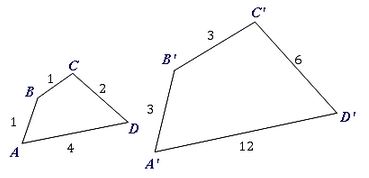Similar figures
Two shapes, or figures, are said to be similar if they are the same shape but different sizes. Two key features of similar figures are:
- Corresponding angles are equal
- Corresponding sides are proportional, meaning they have been multiplied by the same scale factor.
Similar shapes are either enlargements or reductions of one another.
Enlargements
A shape is considered an enlargement of another if one shape has side lengths that are all increased by the same scale factor.
Worked example
example 1
Take a triangle with side lengths measuring $3$3 cm, $4$4 cm and $5$5 cm. If each side is multiplied by the same factor, say $2$2, the new resulting triangle will have side lengths measuring $6$6 cm, $8$8 cm and $10$10 cm. The resulting shape is larger.
Reductions
A shape is considered a reduction of another if one shape has side lengths that are all decreased by the same scale factor.
Consider the reverse of the above example: a triangle with side lengths measuring $6$6 cm, $8$8 cm and $10$10 cm has each side multiplied by a factor of $\frac{1}{2}$12. The new resulting triangle will have side lengths measuring $3$3 cm, $4$4 cm and $5$5 cm. The resulting shape is smaller than the original.
The scale factor tells us by how much the object has been enlarged or reduced.
The scale factor can be greater than $1$1, so the image is being made bigger than the original.
The scale factor can be smaller than $1$1, so the image is being made smaller than the original.
Worked examples
example 2
The shape ABCD has been enlarged to A'B'C'D'. Find the scale factor.

To find the scale factor we:
a) identify corresponding sides, in some cases this might mean rotating the shape.
b) compare the ratios of the matching sides.
By aligning the largest length sides, AD and A'D', with each other then using this to match up the other sides, we can produce this table.
| Side | Length | Side | Length | Scale factor |
|---|---|---|---|---|
| AD | $4$4 | A'D' | $12$12 | $12\div4=3$12÷4=3 |
| DC | $2$2 | D'C' | $6$6 | $6\div2=3$6÷2=3 |
| CB | $1$1 | C'B' | $3$3 | $3\div1=3$3÷1=3 |
| BA | $1$1 | B'A' | $3$3 | $3\div1=3$3÷1=3 |
Because shape A'B'C'D' has all side lengths $3$3 times larger than the corresponding sides of shape ABCD we say that it has been enlarged by a factor of $3$3.
Practice questions
Question 1
The green rectangle is an enlargement of the blue rectangle.
What is the enlargement factor?
Write the scale of the blue rectangle to the green rectangle.
$\editable{}:\editable{}$:

